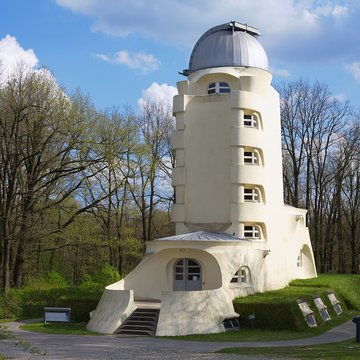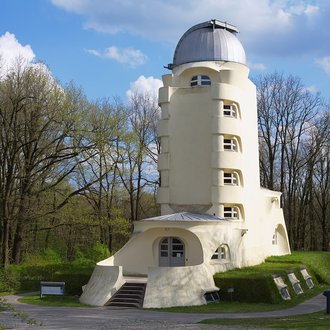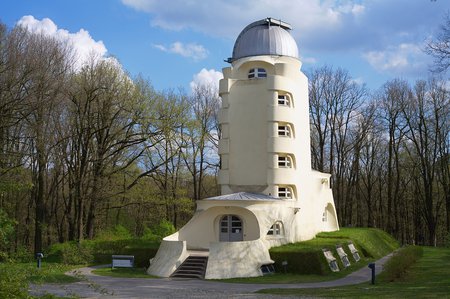Getty Grant for Einstein Tower
The Getty Foundation announces a second series of grants for exemplary 20th century buildings as part of its Keeping It Modern initiative. The Einstein Tower receives one of the fourteen grants totaling over $1.75 Million awarded for the conservation of modern architecture around the world. The grant will be used for conservation planning and understanding about the proper treatment of the Einstein Tower.
„The Einstein Tower takes a particular role in our efforts to actively maintain our rich science-historical heritage,“ says Prof. Dr. Matthias Steinmetz Chairman of the AIP Board. „The Getty Grant allows us to develop a sustainable long-term conservation plan and maintain the Einstein Tower as a science-technical landmark, monument and active research facility.“
The solar observatory at the Leibniz Institute for Astrophysics in Potsdam, better known as the Einstein Tower, is architect Erich Mendelsohn’s signature building and a paragon of German expressionism.
As the first solar tower telescope in Europe, the building was intended to support Einstein’s study of relativity, and it continues to function as a research center today. Breaking away from the paradigm of rectangular post and beam architecture, Mendelsohn crafted an organic and sinuous form to reflect the new models of the universe then in development. The use of reinforced concrete to create a smooth, unified skin over the building’s brick substrate was innovative at the time and enabled its expressive plastic form. However, this experimental combination of materials has left the structure vulnerable to water infiltration that threatens the safety of its scientific equipment.
The Getty grant will support an in-depth study of the building’s moisture problems, including the thermal stress of fluctuating seasonal conditions that is a shared concern among concrete buildings in temperate climates.
“Modern architecture is a defining artistic form of the 20th century at considerable risk, often due to the cutting-edge building materials that characterized the movement,” says Deborah Marrow, director of the Getty Foundation. “This new round of Keeping It Modern grants includes some of the finest examples of modern architecture in the world. The grant projects address challenges for the field of architectural conservation and will have impact far beyond the individual buildings to be conserved.”
Read more:
Keeping It Modern Press Release [not available anymore]
Contact:
Head of Solar Observatory Einstein Tower: apl. Prof. Dr. Carsten Denker cdenker@aip.de, +49 331 7499-297
Press and Public Outreach: Dr. Janine Fohlmeister, presse@aip.de, +49 331 7499-383
The Getty Foundation announces a second series of grants for exemplary 20th century buildings as part of its Keeping It Modern initiative. The Einstein Tower receives one of the fourteen grants totaling over $1.75 Million awarded for the conservation of modern architecture around the world. The grant will be used for conservation planning and understanding about the proper treatment of the Einstein Tower.
„The Einstein Tower takes a particular role in our efforts to actively maintain our rich science-historical heritage,“ says Prof. Dr. Matthias Steinmetz Chairman of the AIP Board. „The Getty Grant allows us to develop a sustainable long-term conservation plan and maintain the Einstein Tower as a science-technical landmark, monument and active research facility.“
The solar observatory at the Leibniz Institute for Astrophysics in Potsdam, better known as the Einstein Tower, is architect Erich Mendelsohn’s signature building and a paragon of German expressionism.
As the first solar tower telescope in Europe, the building was intended to support Einstein’s study of relativity, and it continues to function as a research center today. Breaking away from the paradigm of rectangular post and beam architecture, Mendelsohn crafted an organic and sinuous form to reflect the new models of the universe then in development. The use of reinforced concrete to create a smooth, unified skin over the building’s brick substrate was innovative at the time and enabled its expressive plastic form. However, this experimental combination of materials has left the structure vulnerable to water infiltration that threatens the safety of its scientific equipment.
The Getty grant will support an in-depth study of the building’s moisture problems, including the thermal stress of fluctuating seasonal conditions that is a shared concern among concrete buildings in temperate climates.
“Modern architecture is a defining artistic form of the 20th century at considerable risk, often due to the cutting-edge building materials that characterized the movement,” says Deborah Marrow, director of the Getty Foundation. “This new round of Keeping It Modern grants includes some of the finest examples of modern architecture in the world. The grant projects address challenges for the field of architectural conservation and will have impact far beyond the individual buildings to be conserved.”
Read more:
Keeping It Modern Press Release [not available anymore]
Contact:
Head of Solar Observatory Einstein Tower: apl. Prof. Dr. Carsten Denker cdenker@aip.de, +49 331 7499-297
Press and Public Outreach: Dr. Janine Fohlmeister, presse@aip.de, +49 331 7499-383
Images
The Einstein Tower on the Telegrafenberg in Potsdam, Germany.
Big screen size [1000 x 665, 190 KB]
Original size [1503 x 1000, 420 KB]





